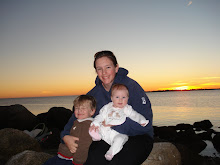Both of them involve my two and a half year old daughter. As I did with her older brother, I have read to her every day since she was a newborn. It's something I have always loved to do, and I can honestly say that few things in life make me feel happier or more content than being snuggled up with my kids reading a book. We read at various times throughout the day, but bedtime is always my favorite. Mostly, this is because no matter how crazy the day was or how stressful the whole bathtime/teeth brushing/pj wrangling/bed bouncing/sibling chasing/bedtime routine has been, cuddling up to read stories washes all of that away. I've written about why I read to my children before, and these two moments I witnessed this week offer perfect examples of just how influential and meaningful our story times really are.
Here's what happened.
As she so often does, my daughter requested "Just one more story!" before bed. We turned to the stack of board books on the little table next to our rocking chair, and she requested Sandra Boynton's Blue Hat, Green Hat. (I strategically leave short books like this one in plain view so that we can read one more story without having it take too long.) As I opened the book and began to read, I started to do what I always do with this story: point to each picture as I say it out loud. ("Blue hat, green hat, red hat, oops!") My daughter quickly said, "No, no, I will do it!" and proceeded to point to each picture herself, at which point I would read the accompanying text. Sounds simple enough, I know, but here is what I realized. She pointed to each picture in the proper sequential order -- top to bottom, left to right -- without any guidance from me. I waited to read aloud until she had pointed to the pictures, and we went through the whole story that way. We hadn't read this particular book in a few months (I had recently found it back behind a bookcase), so I doubt she simply had it memorized from the last time we had read it. I don't always point to the text as I read, but apparently, I do it often enough that my daughter knows to read from top to bottom and left to right. It's a little thing, of course, but it shows that children learn some of the fundamental concepts of literacy long before they learn to read.
Yesterday, I witnessed another awesome literacy moment. It was one of those rare occasions where I'm able to quietly listen in on what my children are doing without them knowing that I am there. (Don't you just love that?) My daughter was standing by her rocking chair "reading" one of her favorite books at the moment: Pete the Cat and His Four Groovy Buttons. She got the book out of the bin next to the chair, placed it on the seat, opened it up, and began reading it aloud to herself. As she went on, I was amazed by three things: 1) She knew the entire story, word for word, even the cute little things Pete says in the illustrations like, "It's all good!" 2) She knew exactly when to turn the page; and 3) She read with the same inflection and expression that I do when I read the story aloud to her. I know she wasn't really "reading," she was reciting the book from memory, but I was amazed, nevertheless. I wasn't surprised, but I was amazed.
Oftentimes, when we read aloud to our children, we know that they are listening. (Sometimes, of course, they're not, in which case maybe it's better to try a different story and return to that one another time.) But it's important to realize just how closely they are listening. They're taking in so much more than the story line itself. All of the things we do when we read aloud -- our expression, emotion, intonation, inflection, volume, timing -- come together to tell them the whole story in a way that simply speaking the words cannot. In this sense, the way we read a story aloud is as important as the act of reading, itself. And those sweet little listeners on our laps? They are taking it all in. Word by word, story by story.
When we read with our children, we're doing so much more than simply entertaining them with stories. We're teaching them about language, expression, grammar, diction, vocabulary and a whole host of other literacy skills in between. Although we might not realize it, we're laying the foundation for a love of learning and setting them up to be successful readers long before we'd ever expect them to learn to "read." Those amazing little minds are learning far more than we ever intended, and that is a pretty awesome thing.

















































